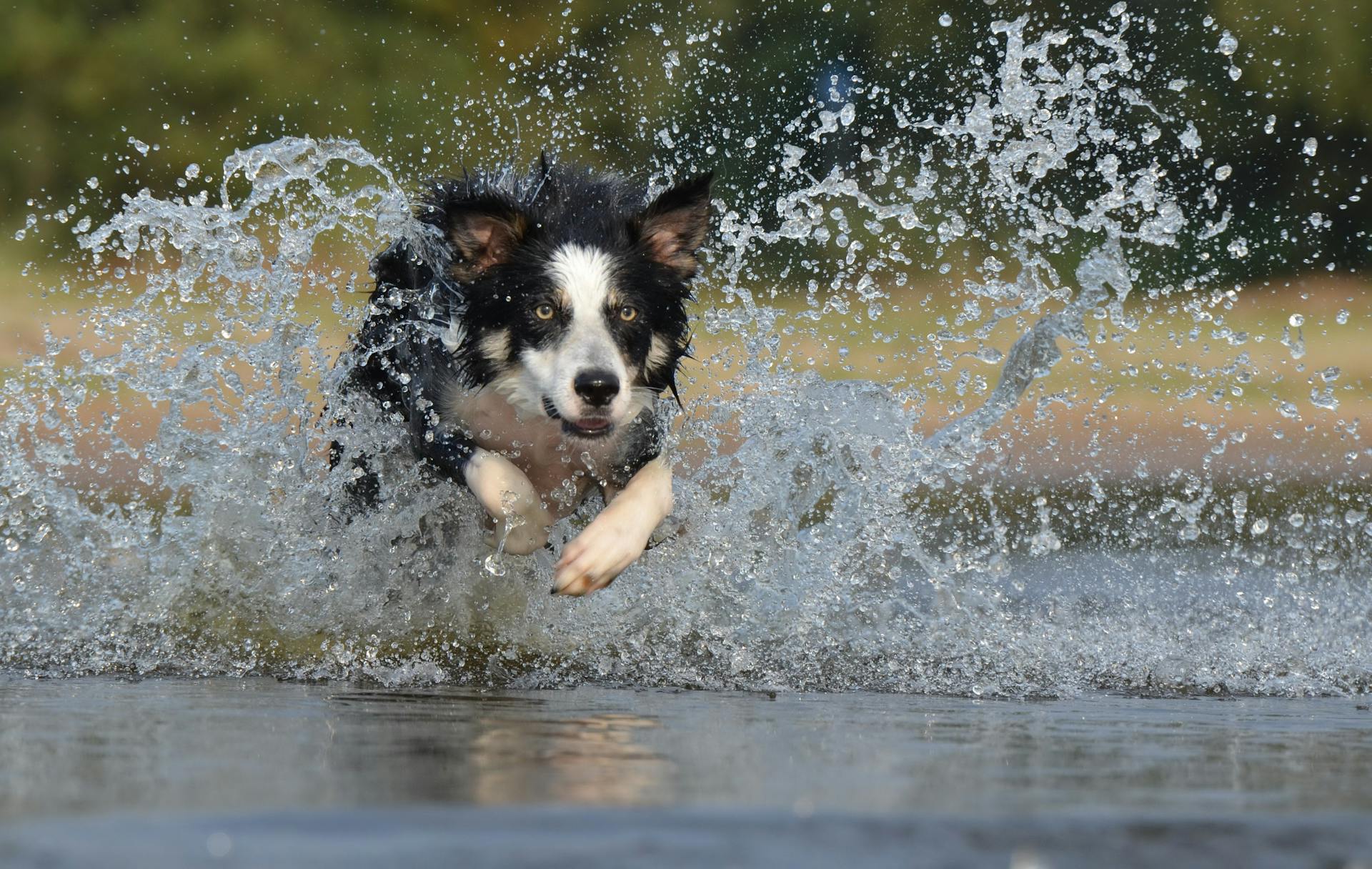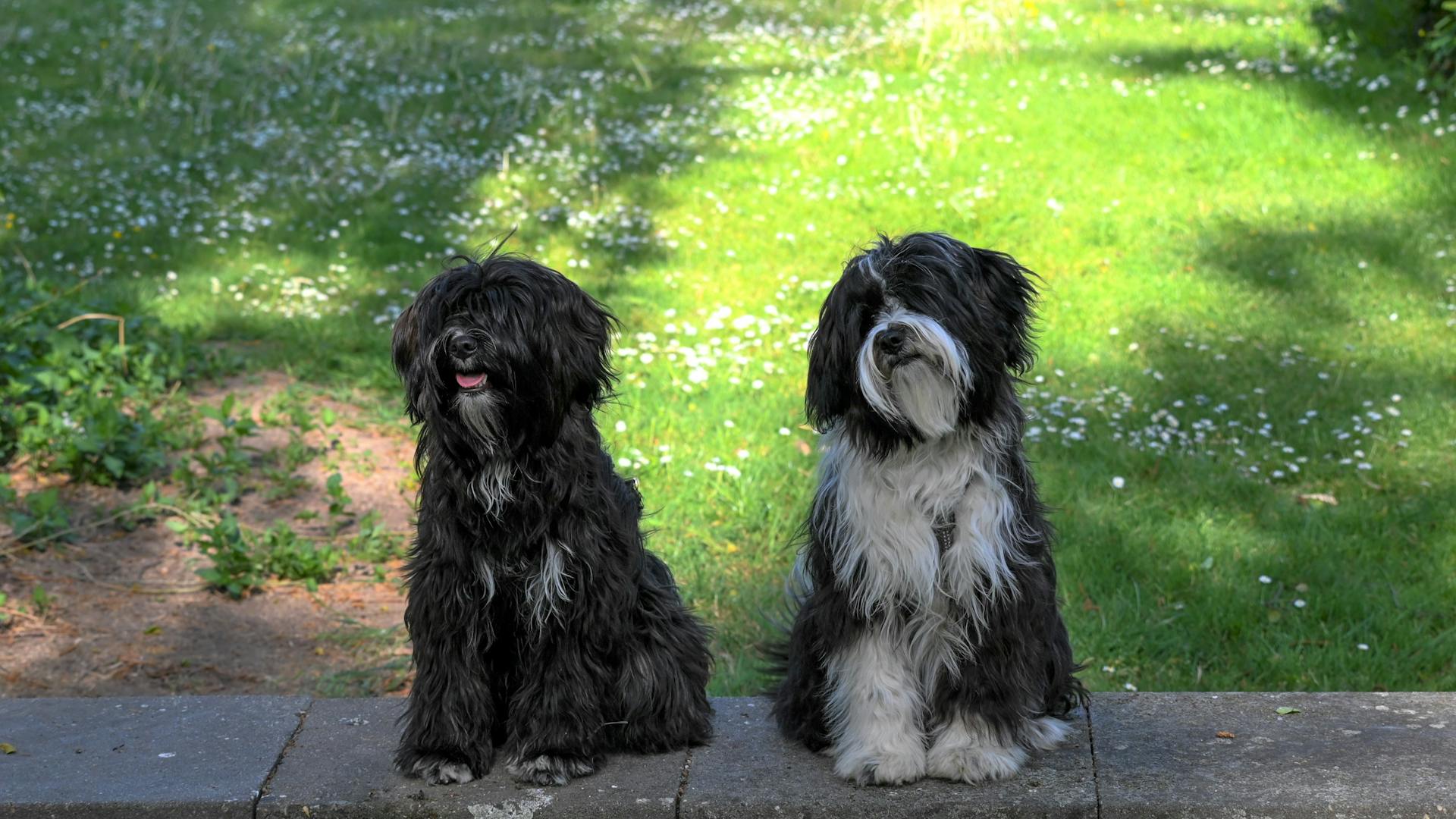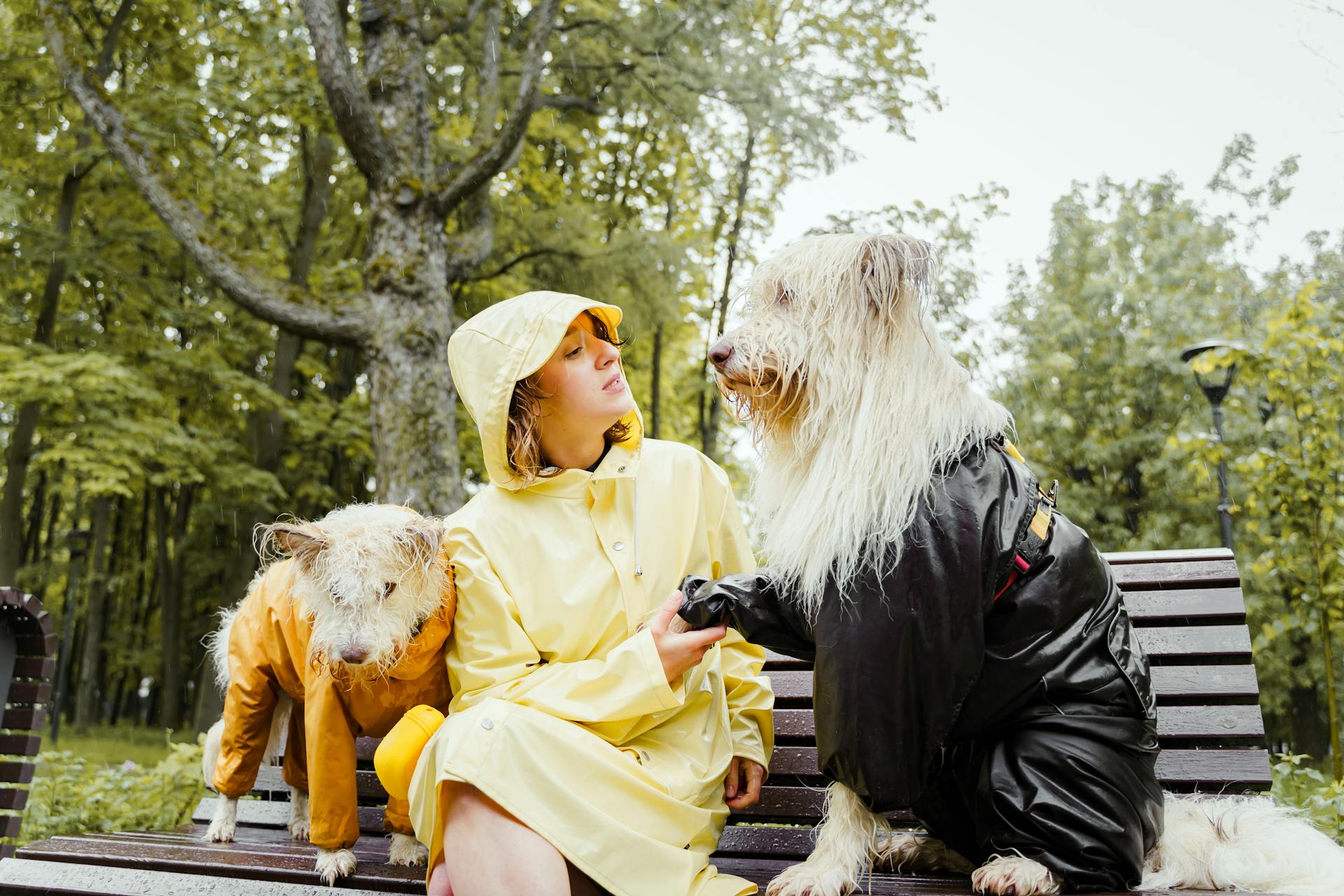
If you're considering adopting a Karelian Bear Dog, be prepared for a lifelong commitment. These dogs are bred to hunt and can be quite energetic.
Karelian Bear Dogs are highly intelligent and trainable, but they can be strong-willed and independent. They thrive on structure and clear boundaries.
Their thick coats require regular grooming to prevent matting and tangling. Regular exercise and mental stimulation are also essential to keep them happy and healthy.
In terms of living arrangements, Karelian Bear Dogs do best in homes with secure fencing and a large yard.
Breed Characteristics
The Karelian Bear Dog is a medium-sized breed with a short, dense double coat that's typically black and white. This coat type helps them thrive in cold climates.
Their size is relatively consistent, ranging from 19 to 24 inches in height and 33 to 50 pounds in weight. This makes them a sturdy breed, capable of handling rugged outdoor conditions.
Here are some key characteristics of the Karelian Bear Dog breed:
Their lifespan is relatively long, with an average of 10 to 12 years. This means they can be a long-term companion for experienced owners.
Size
The Karelian Bear Dog is a medium-sized breed with a sturdy build. Males typically stand between 21 and 24 inches tall at the shoulder, while females are slightly smaller, measuring between 19 and 22 inches.
In terms of weight, Karelian Bear Dogs generally range between 44 and 50 pounds. This weight range can vary depending on individual dogs, but overall, they are a medium-sized breed.
Here's a comparison of the height and weight ranges for Karelian Bear Dogs:
Overall, the Karelian Bear Dog's size is well-suited for its purpose as a working dog, requiring high energy levels and a sturdy build to manage bear populations in national parks.
Fun Facts
Karelian bear dogs are known for their remarkable sisu, a Finnish word that embodies traits like strength, courage, honor, and perseverance in the face of adversity.
The breed's rich history is a testament to its resilience, having nearly gone extinct in World War II. Today's Karelians come from just 43 animals, a remarkable recovery thanks to the Finnish Kennel Club's efforts.
Here are some key facts about the Karelian bear dog's history and characteristics:
- Origin: Finland
- Number of ancestors: 43
- Guidance: Finnish Kennel Club
Karelian bear dogs have an impressive job in Alaska, where they're used by professional handlers to humanely locate and deter bears with their barking.
Care and Feeding
Regular nail care is essential for Karelian Bear Dogs as their nails grow quickly and can become cracked, split, or broken if not trimmed or ground regularly.
To ensure good oral hygiene, brush your Karelian Bear Dog's teeth regularly, as advised by a veterinarian. This will help prevent dental issues and keep their mouth healthy.
You'll also need to check their ears for signs of infection, parasites, or debris and keep them clean to maintain their overall ear health. Regular veterinary visits are crucial for their ongoing good health and well-being.
A well-balanced diet is vital for a mid-sized Karelian Bear Dog, considering their above-average energy and exercise requirements. They typically consume less food compared to other dogs of similar weight and energy levels, so it's essential to seek guidance from a veterinarian or professional nutritionist to determine the best diet and portion sizes for your dog.
Moderate exercise, such as free play or running in a fenced yard, is a must for Karelian Bear Dogs, as is mental stimulation, such as indoor games of hide-and-seek or learning a new trick.
A different take: Dog Food for High Energy Dogs
Feeding
A well-balanced diet is essential for a mid-sized Karelian Bear Dog, considering their above-average energy and exercise requirements. They typically consume less food compared to other dogs of similar weight and energy levels.
To ensure optimal nutrition for your Karelian Bear Dog, it's recommended to seek guidance from your veterinarian or a professional nutritionist. They can provide expert advice on the appropriate diet and portion sizes.

Their dietary needs will evolve as they transition from puppyhood to adulthood and later into their senior years. Staying informed about these changing nutritional requirements is crucial for their overall health and well-being.
Karelian Bear Dogs may have different dietary needs depending on their individual energy levels, with some requiring a more conservative meal plan and others a more robust diet.
How to Care
Regular brushing is a must for Karelian Bear Dogs, with weekly sessions ideal for most of the year. Their coat can get quite dirty, so occasional baths are necessary.
Trimming their nails is crucial to prevent cracking, splitting, or breaking. You'll need to pay attention to their nails and trim them before they start clicking on the floor.
Brushing their teeth regularly is essential to prevent gum and tooth disease. It's also a great opportunity to bond with your Karelian Bear Dog.
Their ears need regular checking for excess wax, dirt, or debris, especially after outdoor adventures. This will help keep them healthy and happy.

A well-balanced diet is essential for Karelian Bear Dogs, with a mid-sized dog requiring less food than you might expect. Consult with a veterinarian or a professional nutritionist to determine the best diet for your furry friend.
Karelians need plenty of outdoor exercise, with daily hiking sessions ideal. A large yard can be helpful, but be aware that they're known escape artists, so you'll need a sturdy fence.
Regular veterinary visits are crucial to ensure the ongoing good health and well-being of your Karelian Bear Dog. This will help catch any potential issues before they become major problems.
Health
Karelian Bear Dogs are generally a healthy breed, but like all breeds, they can be prone to certain health issues. They have a lower incidence of genetic conditions compared to other purebred dogs.
Hip dysplasia is a potential concern, and owners should be vigilant in monitoring their dog's health. Regular veterinary check-ups can help catch any potential issues early on.
Karelian Bear Dogs are slow to reach their full physical potential, and they continue to mature mentally until they're 4-6 years old. This means they may look mature physically when they're young, but they still have some growing to do.
The official lifespan of a Karelian Bear Dog is 11-13 years, which is a relatively long lifespan for a breed. However, they can be prone to eye problems such as cataracts and progressive retinal atrophy as they age.
Here are some common health issues to be aware of in Karelian Bear Dogs:
- Hip dysplasia
- Cataracts
- Progressive retinal atrophy
Because Karelian Bear Dogs are a rare breed, it's unlikely that your vet will have seen the breed before. Be sure to communicate closely with your breeder to ensure you're fully informed about your dog's health background.
Living with a Karelian Bear Dog
Living with a Karelian Bear Dog requires a lot of outdoor exercise, ideally with a daily hike or jog. They're escape artists, so a sturdy fence is a must.
A large yard is ideal, but be aware that Karelians can be difficult to contain due to their clever nature. One owner even had to replace a chain link fence with welded, galvanized steel panels.
Karelians don't enjoy repetitive games like fetch, but they love swimming and can be great in the house if they get enough exercise. Crate training is also a good option if you can't provide enough physical stimulation.
Here are some key things to keep in mind when living with a Karelian Bear Dog:
Family
Living with a Karelian Bear Dog means being prepared for a high-energy companion that requires plenty of outdoor activity. They are bred to hunt big game, including moose and bear, so it's essential to keep them secure on a leash or in a fenced-in area to prevent wandering or chasing.
A Karelian Bear Dog's strong prey drive means they may not be the best fit for families with young children who may not understand how to interact with dogs gently. However, with proper supervision and training, they can be a great addition to families with kids who are dog-savvy.
These dogs are naturally protective of their families and can be wary of strangers, so it's crucial to introduce new people to the household gradually. They may also be territorial towards male dogs, but are generally friendly towards people.
In terms of grooming, Karelian Bear Dogs have a harsh, straight, medium-length double coat that requires minimal maintenance. They are also relatively low-maintenance when it comes to heat sensitivity, making them a great breed for families who live in warmer climates.
Here are some key characteristics to consider when deciding if a Karelian Bear Dog is right for your family:
- High energy levels and athletic nature require plenty of outdoor activity
- May be best suited for families with older children who are dog-savvy
- Can be wary of strangers and territorial towards male dogs
- Has a harsh, straight, medium-length double coat that requires minimal maintenance
- Relatively low-maintenance when it comes to heat sensitivity
Living Needs
Karelian bear dogs need plenty of outdoor exercise every day.
To meet their exercise needs, it's essential to have a significant amount of outdoor space, such as acreage. A large yard can be helpful, but be aware that Karelian bear dogs are notorious escape artists, so you'll need a sturdy fence that can withstand their attempts to escape.
They don't tend to enjoy dog sports like agility, and repetitive games like fetch can leave them bored. On the other hand, they often enjoy swimming and can be great companions in the house if they get at least one solid workout session a day.
Karelian bear dogs are generally clean, tidy, and happy to lie in front of a fireplace. However, if they don't get enough exercise, they may find their own ways to burn off energy, which can be... messy.
Adoption and Rescue
If you're considering adopting a Karelian Bear Dog, it's essential to explore local shelters or online rescue databases, which allow you to search for adoptable dogs based on breed and location.
Karelian Bear Dog Rescue Groups are limited, and most breeders don't have a dedicated rescue program.
You can find Karelian Bear Dogs in need of a loving home by searching online rescue databases or visiting your local shelters.
These dogs are often used in hunting and tracking, but they also make excellent family companions due to their loyalty and protective nature.
Their high energy levels require regular exercise, so it's crucial to find a household that can provide them with ample physical activity.
Karelian Bear Dogs are intelligent and independent, which makes them versatile working dogs, but it also means they need a family that can keep up with their problem-solving abilities and resourcefulness.
General Information
The Karelian Bear Dog is a rare breed, with only a few hundred registered annually in the US. They originated in Finland and Russia to hunt large game.
This breed is known for its intelligence, courage, and protective nature, making them a great companion for active families. They are naturally wary of strangers and will defend their family if necessary.
Karelian Bear Dogs are medium-sized dogs, typically weighing between 70-110 pounds and standing 20-24 inches tall at the shoulder. They have a thick double coat that sheds heavily.
They require regular exercise and mental stimulation to prevent boredom and destructive behavior. A daily run or hike is a great way to keep them happy and healthy.
Frequently Asked Questions
Do Karelian bear dogs bark?
Yes, Karelian Bear Dogs are known to bark, particularly when marking game. They are also prone to barking as an eager hunter.
Are Karelian bear dogs good pets?
Karelian Bear Dogs are loyal and loving companions, but they require dedicated owners who can provide attention and companionship. They thrive with owners who can spend quality time with them, making them a great fit for active families or individuals.
How rare is a Karelian Bear Dog?
The Karelian Bear Dog is a rare breed in the United States, but relatively common in its native Finland. This unique breed remains a sought-after companion for those interested in its hunting and guarding heritage.
Sources
- https://dogtime.com/dog-breeds/karelian-bear-dog
- https://www.dailypaws.com/dogs-puppies/dog-breeds/karelian-bear-dog
- https://dogacademy.org/breeds/karelian-bear-dog
- https://www.petfinder.com/dogs-and-puppies/breeds/karelian-bear-dogs-puppies/
- https://www.filson.com/blog/profiles/karelian-bear-dogs-hunter-turned-protector/
Featured Images: pexels.com


